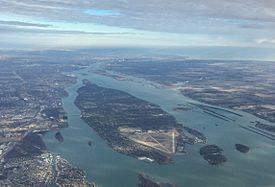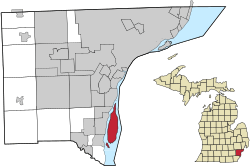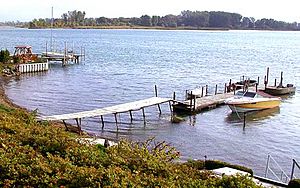Grosse Ile Township, Michigan facts for kids
Quick facts for kids
Grosse Ile Township, Michigan
|
|
|---|---|

Aerial view of Grosse Ile Township looking north
|
|

Location within Wayne County
|
|
| Country | |
| State | |
| County | Wayne |
| Settled | 1776 |
| Organized | 1914 |
| Area | |
| • Civil township | 18.67 sq mi (48.36 km2) |
| • Land | 9.20 sq mi (23.83 km2) |
| • Water | 9.47 sq mi (24.53 km2) |
| Elevation | 594 ft (181 m) |
| Population
(2020)
|
|
| • Civil township | 10,788 |
| • Density | 1,127.3/sq mi (435.3/km2) |
| • Metro | 4,285,832 (Metro Detroit) |
| Time zone | UTC-5 (EST) |
| • Summer (DST) | UTC-4 (EDT) |
| ZIP code(s) |
48138 (Grosse Ile)
48192 (Wyandotte) |
| Area code(s) | 734 |
| FIPS code | 26-35420 |
| GNIS feature ID | 1626407 |
Grosse Ile Township is a special kind of town in Wayne County, Michigan. It's made up of several islands in the Detroit River. The biggest island is also called Grosse Ile.
French explorers gave the island its name in 1679. Grosse Île means "Big Island" in French. The area became part of the United States after the American Revolutionary War. Grosse Ile Township was officially formed in 1914. In 2020, about 10,788 people lived here.
Contents
Exploring Grosse Ile's Geography
Grosse Ile is the largest island in the Detroit River. The township itself includes twelve islands. However, most people think of the main island when they say "The Island."
The main island is actually two islands connected by bridges. The northern tip is called Hennepin Point. It's named after a French explorer and is mostly wild. A small canal separates it from the rest of the northern part.
The southern part of the main island is separated by the Thorofare Canal. This canal connects two parts of the Detroit River. Bridges link the southern main island to other inhabited islands like Elba, Meso (Upper Hickory), Hickory, and Swan Island.
Islands and Waterways
Many smaller, uninhabited islands are near Grosse Ile's main island. These include Calf Island, Celeron Island, Dynamite Island, Fox Island, Stony Island, and Sugar Island. Some of these islands are protected areas. For example, Calf Island is part of the Detroit River International Wildlife Refuge.
Two bridges connect Grosse Ile's main island to the Michigan mainland. The Grosse Ile Toll Bridge is on the north side. The Wayne County Bridge, often called the "Free Bridge," is on the south side.
A Look at Grosse Ile's History
Early Days and Founding
The Potawatomi people lived on the island for a long time. They called it Kitcheminishen. Three nations' flags have flown over Grosse Ile: France, England, and the United States.
French explorers first visited the island in the late 1600s. Father Louis Hennepin, a Catholic priest, explored the Great Lakes in 1679. He wrote about the island's fruit and animals. Hennepin Point is named in his honor.
In 1701, French explorer Antoine de la Mothe Cadillac camped on Grosse Ile. The next day, he claimed the area for France. This spot is now in Detroit.
Britain took control of the island in 1763 after the French and Indian War. They changed the spelling to "Grosse Isle."
On July 6, 1776, the Potawatomi leaders sold the island to two brothers, Alexander and William Macomb. They were important fur traders in Detroit. The Macomb brothers are seen as the first European-American settlers.
Settlement and Growth
Settlement on Grosse Ile began in the 1800s. Some old homes built by Macomb family members are still standing. The Rucker Homestead, built in 1816, is the oldest building still in use.
Westcroft Gardens is a historic farm run by Macomb descendants. It's known for growing azaleas and rhododendrons. It's one of Michigan's oldest farms still owned by the same family.
Macomb Street, a main street in Grosse Ile, is named after the Macomb brothers. A monument marks where the deed was signed. The original deed is kept in the Detroit Public Library.
Boating and Water Fun
Boating has always been important on Grosse Ile. Native Americans used canoes. Early European settlers used sailboats.
By the late 1800s, Grosse Ile was a popular spot for boaters. Steamboats brought people from Detroit. Sugar Island, one of Grosse Ile's islands, had an amusement park and beach.
Wealthy families built summer homes along the shoreline. They enjoyed views of the Detroit River and Lake Erie. The island's population was small, with most houses near the water.
In 1894, the Grosse Ile Light was built to guide ships. It was rebuilt in 1906 into the classic white lighthouse you see today. It's a symbol of Grosse Ile. The lighthouse is now a museum run by the Grosse Ile Historical Society. You can visit it once a year.
In 1905, island resident Cameron Waterman invented the outboard motor. He tested it in the Detroit River. His company made many motors.
During the Prohibition era, Grosse Ile was a crossing point for bootleggers. They illegally brought alcohol from Canada by boat or even by car across the frozen river.
Aviation and Military History
In the 1920s and 1930s, a small airport on Grosse Ile was important for early aviation. The Curtiss-Wright Flying Service had a flight school there. The world's first all-metal airship, the ZMC-2, was built here for the Navy. Famous pilot Amelia Earhart may have visited the airfield.
Grosse Ile was home to a U.S. Navy base for 40 years. The U.S. Naval Air Station Grosse Ile opened in 1929. During World War II, it became a major training center for American and British pilots. George H. W. Bush, who later became President, trained here in 1945.
During the Cold War, the U.S. Army put Ajax-Nike missiles at the airfield from 1954 to 1963. The Navy closed the base in 1969. In 1971, it became the Grosse Ile Municipal Airport for civilian use.
Today, the airport is used for general aviation and airshows. It sometimes hosts blimps. The Grosse Ile Township Hall is also located at the airport.
Railroads and Bridges
In 1873, the Canada Southern Railroad built a railway from the mainland to Grosse Ile. It carried passengers and goods. Trains crossed the island and were ferried to Ontario, Canada. This service lasted about ten years.
Later, the Michigan Central Railroad (MCR) ran trains between the island and Trenton, Michigan. From Trenton, people could connect to Detroit. In 1904, MCR built a small train depot on the island.
Train service slowed after the Grosse Ile Toll Bridge opened for cars in 1913. This private bridge connects Grosse Ile to Riverview. Car travel became more popular. MCR stopped passenger service in 1924 and freight service in 1929.
In 1931, the county turned the old MCR rail bridge into the Wayne County Bridge for cars, bikes, and walkers. The old train tracks on the island became Grosse Ile Parkway. This bridge is called the "Free Bridge" because it doesn't charge a toll.
Today, most traffic uses the Wayne County Bridge. The Toll Bridge has closed temporarily twice after being hit by large ships.
Grosse Ile Historic District
The old MCR train depot is now a museum run by the Grosse Ile Historical Society (GIHS). The old U.S. Customs House is also nearby. These are the only public buildings in the National Historic District on East River Road.
The district also includes Saint James Episcopal Church, built in 1867. It's the oldest church on the island. Six historic homes from the 1840s to 1860s are also part of the district.
Modern Times and Preservation
Grosse Ile offers great views of ships on the Detroit River. Large cargo ships and pleasure boats often pass by the east side of the island.
In the middle of the island, the Jewell Colony subdivision has about a dozen 1920s homes listed on the Michigan Register of Historic Places. It was the first planned neighborhood on the island.
Grosse Ile grew a lot in the late 1900s. To protect its natural beauty, the township started an "Open Space Program" in the 1990s. They bought undeveloped land to slow building and protect the environment.
A group of residents also formed the Grosse Ile Land & Nature Conservancy in 1993. This group helps protect the island's natural areas. They manage a 40.5-acre marsh and upland area at the airport. This "Nature Area" is used by teachers and Boy Scout groups to teach about nature.
Money magazine named Grosse Ile one of the "Top 100 Best Places to Live" in 2009.
Grosse Ile's Culture and Community
The annual "Islandfest" is a fun event held near the Grosse Ile Municipal Airport. The Grosse Ile Youth Recreational Association (GIYRA) hosts a haunted house every Halloween. GIYRA also organizes sports for kids, like football, cheerleading, basketball, baseball, and softball.
The island has an indoor tennis facility with six courts. The Grosse Ile Soccer Association runs a soccer league with many teams.
The Islanders is Grosse Ile's community theater group. It's one of Michigan's oldest civic theater groups, active since 1925. They put on plays for the community.
Grosse Ile has several social clubs. These include the Grosse Ile Yacht Club, Ford Yacht Club, Elba-Mar Boat Club, Grosse Ile Golf and Country Club, West Shore Golf Course, Water's Edge Golf Course, the Kiwanis Club, and the Grosse Ile Rotary Club.
Education in Grosse Ile
Grosse Ile Township Schools serves the township's students.
There are two elementary schools on the island. Parke Lane Elementary is for grades K-2nd. Meridian Elementary is for grades 3rd-5th. Grosse Ile Middle School teaches students in grades 6-8. Grosse Ile High School prepares students for college in grades 9-12. The high school mascot is the Red Devil.
In 2001, The Detroit News ranked Grosse Ile as the top school district out of 88 in Michigan.
Population and Demographics
In 2020, Grosse Ile Township had 10,786 people and 4,250 households. The population density was about 1,194 people per square mile.
Most residents (90.5%) were White. Other groups included 3.4% African American, 0.2% Native American, and 2.6% Asian. About 3.0% were from two or more races. Hispanic or Latino people made up 3.2% of the population.
The average household income in the township was $125,469. The average income per person was $65,696. Only about 3.2% of the population lived below the poverty line.
Grosse Ile is known as one of the safest communities in Michigan.
Notable People from Grosse Ile
Many interesting people have lived in Grosse Ile:
- Harry Bennett, who was Henry Ford's personnel director.
- John Robert Beyster, who started the Science Applications International Corporation.
- Thornton F. Brodhead, an Army veteran and politician.
- Charles T. Fisher, a business leader and car industry pioneer.
- Henry Ford, the founder of the Ford Motor Company, owned land here.
- Max Gail, an actor known for TV, movies, and stage.
- John Karmazin Sr., an inventor and business founder in engine parts.
- Michael D. Knox, an activist, educator, and author.
- William S. Knudsen, a car executive and World War II general.
- Daniel H. Rucker, a U.S. Army brigadier general.
- Ransom E. Olds, a car pioneer who founded the Olds Motor Vehicle Company.
- Heinz Prechter, who founded the American Sunroof Company.
- Jack Telnack, a car designer and executive.
See also
 In Spanish: Municipio de Grosse Ile para niños
In Spanish: Municipio de Grosse Ile para niños






